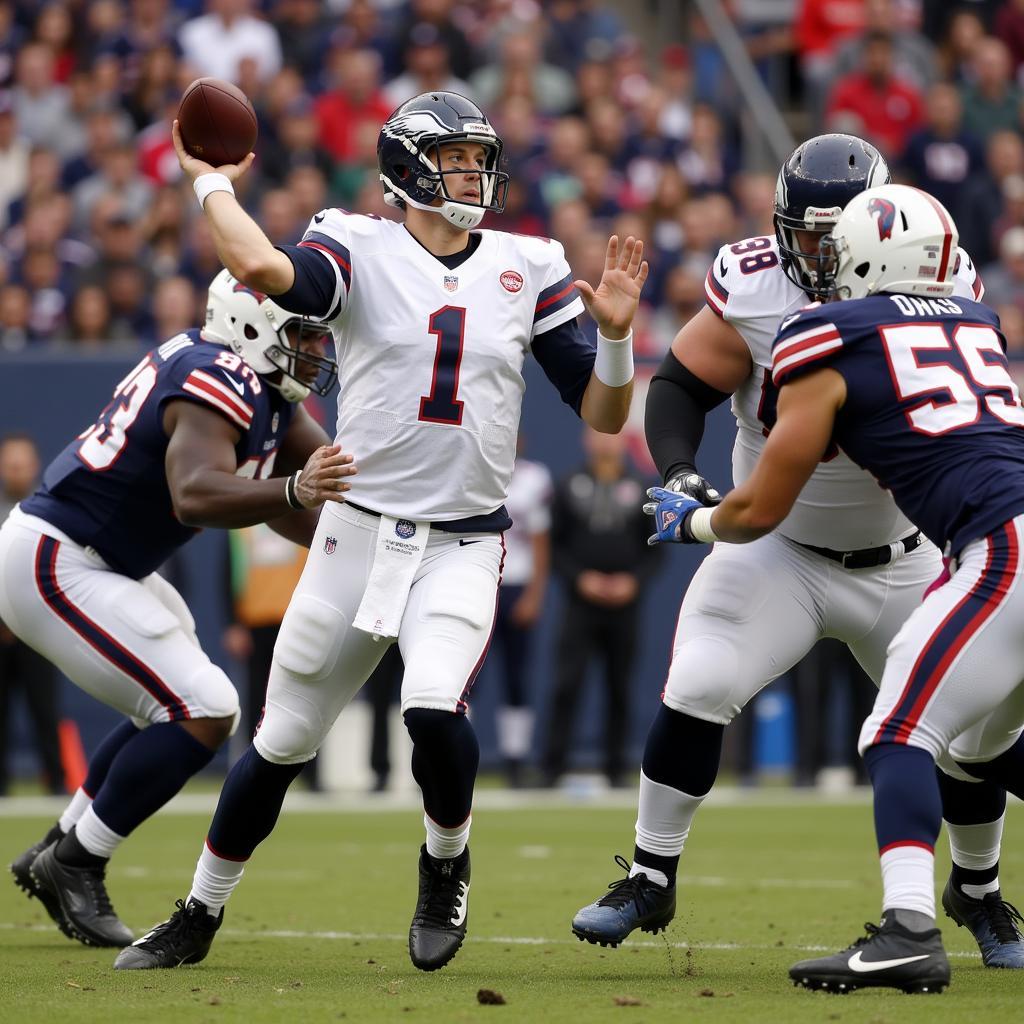What is the Penalty for Intentional Grounding?
November 2, 2024Intentional grounding is a penalty in American football that occurs when a quarterback throws a forward pass while in danger of being sacked, without a realistic chance of completion, and in an attempt to avoid a loss of yardage. Understanding the nuances of this rule is crucial for both players and fans. Let’s delve into the specifics of what constitutes intentional grounding, the penalty incurred, and some common scenarios.
Understanding Intentional Grounding in Football
Intentional grounding is designed to prevent quarterbacks from unfairly manipulating the game by throwing the ball away to avoid a sack. The key elements that officials look for when determining intentional grounding are the quarterback’s position, the presence of eligible receivers, and the likelihood of a completed pass.
Key Elements of Intentional Grounding
- Quarterback’s Position: The quarterback must be under duress, typically meaning they are facing imminent pressure from the defense. Being in the pocket with ample time to throw usually negates this element.
- Eligible Receivers: There must be no eligible receivers in the vicinity of where the ball is thrown. If a receiver has a reasonable chance to catch the pass, even if it’s a difficult one, the grounding penalty is usually not called.
- Likelihood of Completion: The thrown ball must have little to no chance of being caught. A pass that sails well over the head of any receiver or is thrown out of bounds with no nearby eligible receivers would likely be considered intentional grounding.
 Example of Intentional Grounding in Football
Example of Intentional Grounding in Football
The Penalty for Intentional Grounding
The penalty for intentional grounding is a loss of down and a loss of yardage. The yardage lost is typically the distance from the spot of the foul to the line of scrimmage, plus a further 10-yard penalty. In some cases, if the spot of the foul is past the line of scrimmage and behind it, the 10 yard loss penalty can put the ball even further behind the line of scrimmage making it harder for the offense. This can significantly impact a team’s field position and momentum.
Variations in Penalty Enforcement
While the standard penalty is loss of down and loss of yardage, there can be variations. If the spot of the foul is in the end zone, it results in a safety, which awards two points to the opposing team.
Common Scenarios and Examples
There are several common scenarios where intentional grounding occurs. Understanding these scenarios can help clarify the rule. For example, a quarterback rolling out of the pocket and throwing the ball away while under pressure, with no receivers nearby, is a classic example. Another example is when a quarterback, facing a blitz, throws the ball at the feet of an ineligible receiver.
Avoiding Intentional Grounding
Quarterbacks can avoid intentional grounding by throwing the ball towards an eligible receiver, even if the completion is unlikely, or by simply taking the sack. Smart decision-making and awareness of the surrounding players are key to avoiding this penalty.
“Intentional grounding is all about game awareness and risk management. Sometimes, taking the sack is the best option,” says former NFL quarterback, John Smith.
Conclusion
Intentional grounding is a complex rule with significant implications for the game. Understanding the penalty for intentional grounding, which includes loss of down and loss of yardage, is vital for all football enthusiasts. By grasping the key elements and common scenarios, both players and fans can better appreciate the strategic decisions made on the field. Remember, sometimes the best play is to simply take the sack.
FAQ
- What happens if the quarterback throws the ball away in the end zone? A safety is awarded to the opposing team.
- Does the quarterback have to be under pressure to be called for intentional grounding? Yes, generally the quarterback must be under imminent threat of being sacked.
- Can a quarterback throw the ball to an ineligible receiver to avoid intentional grounding? No, throwing to an ineligible receiver is also a penalty.
- Is intentional grounding always called if a quarterback throws the ball out of bounds? Not always, it depends on the location of eligible receivers and the quarterback’s situation.
- What is the difference between intentional grounding and an incomplete pass? An incomplete pass is simply when a forward pass doesn’t connect with a receiver, while intentional grounding is a deliberate act to avoid a sack.
- How does intentional grounding affect field position? It can significantly hurt field position due to the loss of down and yardage.
- Can intentional grounding be reviewed by officials? Yes, like many other penalties, intentional grounding can be reviewed through a coach’s challenge or by the replay official in certain situations.
Other Related Articles
- Understanding the Basics of American Football Rules
- The Role of the Quarterback in Modern Football
- Common Penalties in American Football
If you need assistance, contact us:
Phone: 0915117113
Email: [email protected]
Address: To 3 Kp Binh An, Phu Thuong, Vietnam, Binh Phuoc 830000, Vietnam. We have a 24/7 customer support team.